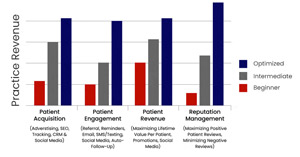Medical Clinic and Dental Practice Marketing Plan For Physicians & Dental Practices – Used by Top Practices in USA & Canada
Medical Clinic and Dental Practice Marketing Plan and Results – Used by Top Practices $799/Mon. Used By Telemedicine Physicians, Dental Practices, Surgeons, Pediatrics, MedSpas, Pain Management, Functional Medicine, Primary & Urgent Care, Cardiologists, Podiatrists, Addiction Medicine, Regenerative, Wellness, Therapy, OBGYN, Integrative Medicine, Dentists, Dermatologists, IVF & Reproductive, Pharma, Bio-Tech & Many Other Medical Practices
Online solutions for Medical clinics and dental practices are not created equal. Let us walk you through a scenario based on a real customer. This practice was servicing 46 patients per day, has 6 exam rooms, with a marketing budget of $6000 per month, spending approximately $2700 per month on multiple solution providers (most of them non HIPAA compliant), a website company, and $2900 per month on Google AdWords. However they could service up to 73 patients per day, they had additional capacity and a non-optimized marketing plan. Read more about Return On Investment (ROI) here.
4 Components of a Marketing Plan for a Medical Clinic and Dental Practice
Traditionally, marketing experts tell us that there are 4 key components of your Medical Marketing Plan.
- The Product or Service – This will be service offerings for your medical practice. For example, if you an Urgent Care clinic, do you offer service to patients based on 12 major categories. Examples will be onsite x-ray, DOT physical exams, lab-test results, sports physicals, simple fracture treatment, travel medicine, immunizations etc. If you are MedSpa / Esthetic based practice, you may want to define your product/service strategy based on competition and availability of your staff’s credentials. For example, if you want to offer “CoolSculpting”, you will need to make an investment in purchasing this technology and training of your staff. So each medical service you offer has a cost associated with it, and of course there could be tangible benefits for your medical practice. So your marketing plan must have a focus on which “services” you are going to offer. And each service deserves its SWOT analysis.
- The Price of the Service – In many cases, this is driven by the insurance company payouts to you. But there are certain procedures that are not covered by the insurance payments. There are additional strategies available to you here. Each patient can be divided into 3 main categories.
- PPO or Full Insurance – These insurance plans pay fixed amount for each procedure for in-network vs out-of-network procedures.
- Self-Pay Patients – Patient pays directly to the provider – you have leverage to provide better service than your competitors and charge more.
- High-Deductible plans – In this case, as an example, patients typically have to pay initial $4000-$10000 out of their pockets. After ta patient has spent these amounts on deductibles, copayments, and coinsurance, then the medical insurance plan pays 100% of the costs of covered benefits. Many patients consider that first $4000-$10000 as something that have to “shop” for prices, hence you have an opportunity to apply your own marketing strategy on how to attract these patients to your practice.
- The Place or Location of Service – For most parts, healthcare delivery system in USA and Canada is very local. Telemedicine can change this in the future, but for now patients typically go to a “local” provider. This is evidenced by 2000% plus increase in Google searches for “Urgent care near me” or “Sleep Apnea doctor near me” or hundreds of other variations based on mobile patients searching for services “near” a patient. So your Place or Location matters.
- The Promotion(marketing) or Advertising of Service – This is one area, where you have true leverage to dominate your medical field. Your medical plan must include the promotion of your service. There are generally 2 main sub-areas for promotion of medical services:
- Offline Promotions – Traditional marketing – includes newspapers, yellow pages, billboards, referrals from peers, networking with other providers and suppliers.
- Online Promotions – This refers to digital marketing and digital advertising to acquire more patients and retain existing patient base.
Case Study: Doctor Smith Example – 6 Exam Rooms – 46 Patients Per Day
Dr. Smith has owned her clinic for 6 years, and was thinking of making some changes to get more patients into her clinic. She knew the internet was the way to go to, if she wanted to generate more patients, and keep her current patients coming back. To be successful and beat out her competitors; Dr. Smith’s clinic needed a great website, online advertising, specifically PPC advertising and Facebook Advertising, effective marketing campaigns, and a powerful medical marketing software to help acquire new patients. So Dr. Smith decided to start getting all the tools and strategies her clinic needed to do all this, and got to work on piecing it all together.
Step 1 – Get an Awesome Website That Converts
She started off by getting a brand new website that improved her branding and helped her stand out from her competitors. But after the new site was up and running, Dr. Smith found out that her website developer didn’t give her a site that’s built to securely handle, and store any potential PHI from patients that could come into her site. After paying a lot for her new site, she now realized she was going to have to pay even more to get this issue fixed, or face some big fines after her next HIPAA audit.
Once the new website was up an running, she realized that Online Advertising was important to acquire new patients quickly. Dr. Smith decided to set up an online advertising campaign through a local digital advertising company to improve her new patient generation, and get her clinic’s patient count up. But with the lack of focus and experience in healthcare and management fees charged by the company, the campaign cost Dr. Smith a lot of money, and didn’t give her the return & ROI she’d expected.
The website management company posted on social media, but the content was non relevant and there were no social media apps to promote her medical clinic with special offers and offer online payments from the Facebook business page.
Step 2. Patient Engagement Plan
To improve her patient engagement, Dr. Smith wanted to put together some effective marketing campaigns for both prospective patients and past patients. She signed up a 2 year contract with a well-known company to send reminders, monthly newsletters and email promotions. This enabled the clinic to deliver personal communication to patients more consistently–with significantly more effort and time as this new tool did not integrate with the number one source of patient acquisition – Website. However, due to all the time it takes her and her staff to create and set-up email campaigns, and put up promotional content on her site, Dr. Smith only sends out effective medical marketing campaigns a couple of times each year.
Key technologies and marketing apps for patient engagement.
- Monthly Email marketing for physicians and medical practices
- Texting/SMS marketing
- Facebook engagement apps
- Auto-responder intelligent apps
- Promotional marketing apps
Step 3. Online Reputation Management Plan – Maximize Positive Reviews & Minimize Negative Reviews
To improve her rankings on online reviews, specially Google Reviews and Yelp reviews, she signed up for a reputation company for $299/mon, with 1 year contract. This resulted in a bad experience as some reviews posted were fake. However, using PatientGain.com software is a painless process and a project manager guides you through the process.
Step 4 – Avoid Risky Plans – Use The Proven Plan Used By The TOP Clinics in USA
After the laborious task of figuring out what her clinic needed, buying all the expensive tools and services, and working to put it all together, Dr. Smith was faced with a new problem: managing her patchwork solution. She had invested all this time and money into the system she had put together, and now Dr. Smith needed to invest even more time to keep it running. The solution she thought would solve all her problems just ended up making things more complicated, and cost her almost as much as the additional revenue it brought in.
Fortunately, it doesn’t have to be like this for your clinic; patient acquisition and engagement doesn’t have to be so painful. PatientGain.com’s Gold service gives your clinic all the software, strategies, and tools it needs to be successful, all within one cloud-based HIPAA compliant solution. With everything under one roof you can get a more streamlined system that produces better results, and that is more cost-effective with better returns on your investment, than a build-it-yourself solution. If you’d like to learn how your clinic can improve your patient acquisition and engagement, contact PatientGain.com.
Step 5 – How do I calculate the patient acquisition cost for my medical practice?
Many medical practice owners incorrectly assume that a marketing budget is the only factor that goes into a patient acquisition cost. While a PAC is used to evaluate how effective marketing campaigns are, other things must be considered when calculating this figure. An accurate patient acquisition cost will include:
- Cost of treatment given to the patient, including any materials used during their appointment (bandages, medications, cosmetic treatments)
- Salary and taxes for staff at a medical practice
- Cost of a marketing company or other vendor fees
- Cost of any research needed before a marketing campaign
- Spend on any marketing materials, if needed
- Marketing budget
As you can see, the total patient acquisition cost is not only a marketing budget number. Some of these factors are one-time costs, while others incur every time you visit a patient. It may be difficult, if not impossible, to nail down an actual number for some of these factors. In these cases, do your best to estimate the cost per patient. Ideally, you want to spread these costs out across as many patients as possible. For example, doing $500 worth of research that applies to 1,000 new patients will be better than 50.


